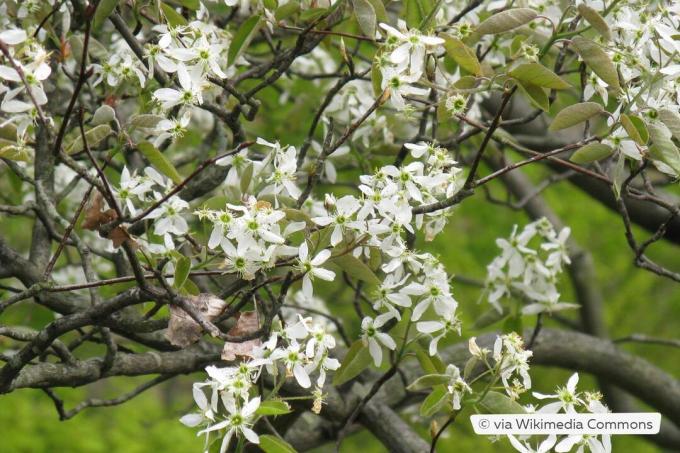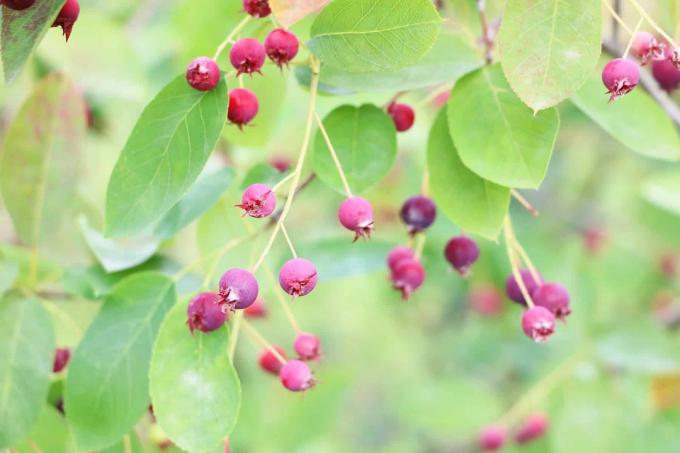
Rock pears are real eye-catchers in the garden. In spring they enchant with their lush abundance of flowers and in autumn with their wonderful leaf color. Below is a list of the most beautiful rock pear species and varieties.
To the point
- originally come from North America
- grow as deciduous shrubs or small trees
- There are approximately 33 species worldwide with countless varieties
- Flowering period April to May
- Edible fruits ready to harvest in June/July
Table of contents
- Originally from North America
- Overview of serviceberry species
- Spiked rock pear
- Tree rock pear
- Alder-leaved rock pear
- Common rock pear
- Japanese rock pear
- Bald rock pear
- Canadian rock pear
- Copper rock pear
- frequently asked Questions
Originally from North America

Service pears (Amelanchier) grow mainly as deciduous, strongly branched shrubs or as a small tree. They grow upright with a spreading crown. The initially green leaves are elliptical, alternate and three to seven centimeters long. In autumn they turn bright orange to dark red. Typically, the mostly star-shaped ones that appear in spring are
white flowers. Small ones ripen from them in the summer Red, blueness or black berry-like fruits. The taste ranges from bland to bitter to sugary sweet. Most types of rose family (Rosaceae) come mainly from North America with the exception of one native species (Amelanchier ovalis) and one from Asia. There are over 30 species of the rock pear genus worldwide. There are also countless varieties of the individual rock pear species known, which we would like to introduce to you in the following list.Tip: These trees can be planted all year round. However, the best time is spring and early summer. The plants then have enough time to root well until autumn.
Overview of serviceberry species
In addition to general information about the species and varieties known in this country, you will also receive tips on planting, care and Location of the rock pear.
Spiked rock pear

This rock pear is particularly suitable for planting in orchards, smaller gardens or in buckets. It loves a sunny to partially shaded location. The tree does not place any great demands on the soil. It must be sandy to loamy, well-drained and rich in limestone.
- Growth: upright, broom-like, forms many root runners
- Height: 120 to 250 cm
- Width: 120 to 220 cm
- Growth: 20 to 40 cm/year
- Flowers: April to May, white, grape-shaped
- Fruits: July, frosted, purple-black, juicy, sweet, edible
A notice: This species is often referred to as the “broom rock pear”.
Tree rock pear

This type of rock pear is particularly good as a flower and Bird protection hedge. At the same time it is a good privacy screen, but can also find a sunny to partially shaded spot as a solitary plant in the home or farm garden. The soil must be slightly moist, rich in humus and nutrients and slightly calcareous.
- Growth: upright, wide and round crown
- Height: 600 to 800 cm
- Width: 200 to 500 cm
- Growth: 40 to 80 cm/year
- Flowers: April to May, grape-shaped, white
- Fruits: July, red to purple, sweet, edible
Known variety:
“Robin Hill”
- Growth: well branched, upright, narrow
- Height: 600 to 800 cm
- Width: 200 to 500 cm
Alder-leaved rock pear

The tree, which is hardy down to -34 degrees, loves a sunny to semi-shady place in the snack and Natural garden. It needs sandy to loamy, well-drained, fresh soil to grow. This type of serviceberry can be planted as a solitary plant or in groups.
- Growth: shrub-like, upright
- Height: 200 to 400 cm
- Width: 100 to 200 cm
- Growth: 10 to 40 cm/year
- Flowers: April to May, pink or white, grape-shaped, self-fertile
- Fruits: June to July, purple to black, sweet, edible
Known varieties:
"Obelisk"
- Growth: tightly upright, slender, columnar
- Height: 300 to 500 cm
- Width 100 to 175 cm
“Northline”
- Growth: multi-stemmed, narrow, upright
- Height: 200 to 400 cm
- Width: 130 to 350 cm
Common rock pear

This robust specimen is one of the most popular rock pear species, is a good plant for birds and is also very popular bee friendly. It is suitable for dry and sunny places in the garden with nutrient-rich soil. The rock pear is used in home and farm gardens, Front gardens as a solitaire, but also planted as a hedge or in pots on the balcony. Frost tolerance is -28 degrees.
- Growth: bushy, upright
- Height: 180 to 350 cm
- Width: 200 to 300 cm
- Growth: 15 to 40 cm/year
- Flowers: April to May, white, grape-shaped
- Fruits: July, black, elongated, sweet, edible
Known variety:
Dwarf rock pear “Helvetica”
- Growth: loose, funnel-shaped, upright
- Height: 150 to 200 cm
- Width: 100 to 200 cm
Japanese rock pear

Source: KENPEI, Amelanchier asiatica6, Edited by Plantopedia, CC BY-SA 3.0
The berries of the insect and bee friendly tree are also for birds a good source of food. This species can be planted as a solitary plant in large gardens or as a hedge in sunny to partially shaded areas. The soil must be well-drained to normal.
- Growth: small trees, multi-stemmed shrubs, upright, loosely fan-shaped
- Height: 500 to 1000 cm
- Width: 500 to 800 cm
- Growth: 20 to 30 cm/year
- Flowers: May, green, grape-shaped
- Fruits: June/July, dark purple, sweet, edible
Bald rock pear

This type of rock pear cannot be missing from the list. With its magnificent yellow to orange autumn color, the rock pear is particularly suitable for planting in mixed areas hedges. The ornamental tree prefers a partially shaded to sunny location with normal, well-drained garden soil.
- Growth: multi-stemmed, upright, broad
- Height: 300 to 500 cm
- Width: 300 to 400 cm
- Growth: 30 to 60 cm/year
- Flowers: April, white, simple, racemose, self-fertile
- Fruits: July, purple, sweet, edible
Known varieties:
"Ballerina"
- Growth: upright, shrub-like, arching, overhanging
- Height: 300 to 600 cm
- Width: 300 to 500 cm
“Snowflake”
- Growth: broad, upright, loosely branched, overhanging tips
- Height: 500 to 800 cm
- Width: 400 to 600 cm
Canadian rock pear

This large shrub is very robust and hardy down to -40 degrees. In its homeland it is used as a medicinal plant. In this country it fits well into natural and cottage gardens. The soil must be dry, low in humus and rich in lime. This rock pear also needs a lot of sun.
- Growth: oval shape, upright
- Height: 50 to 800 cm
- Width: 100 to 200 cm
- Growth: 20 to 40 cm/year
- Flowers: April, white, grape-shaped
- Fruits: June/July, red, sweet, edible
Known variety:
“October Flame”
- Growth: Large shrub, growing upright
- Height: 500 to 600 cm
- Width: 200 to 300 cm
Copper rock pear

The copper rock pear enchants with its beauty in autumn yellow to orange-red autumn foliage. It is often used as a park shrub or for green roofs. In the garden, this species can be used as a solitary plant, hedge or in the garden Perennial border be planted. The tree also thrives in the front garden and in pots on the balcony. It loves a dry, warm and sunny location with moderately acidic soil poor in nutrients and humus.
- Growth: upright, loose, multi-stemmed, umbrella-shaped crown
- Height: 400 to 600 cm
- Width: 500 to 600 cm
- Growth: 20 to 25 cm/year
- Flowers: April, simple, white, in clusters
- Fruits: July, blue to black, spherical, sweet, edible
Known varieties:
“Prince William”
- Growth: narrow, upright, drooping when old
- Height: 150 to 250 cm
- Width: 150 to 200 cm
“Rainbow Pillar”
- Growth: upright, columnar
- Height: 350 to 500 cm
- Width: 130 to 170 cm
A notice: Even if the rock pear as slightly toxic If the berries are freshly harvested (harvest between June and July), they are suitable for fruit salads, mueslis or smoothies. They can also be used to make jams, liqueurs or in cakes.
frequently asked Questions
The best time to prune is immediately after flowering. It is also possible to prune in early spring, before flowering begins. However, the flowers are not very lush. Serviceberries do not tolerate severe pruning. Therefore, only some branches and twigs are removed. If the crowns are too dense, various side branches or base trunks must be removed. They are cut out directly at the branch. No leftover pieces may remain.
Good partners are plants and trees that, like the rock pear, prefer a warm location and dry, nutrient-poor soil. An underplanting can be done with small and large shrubs such as Wild roses (Pink), Cotoneaster (Cotoneaster), serviceberry (Sorbus torminalis) or Barberry (Berberis vulgaris), ornamental grasses How Japanese blood grass (Imperata cylindrica “Red Baron”), red bentgrass (Agrostis capillaris), blue fescue (Festuca glauca), perennials such as Foam blossom (Tiarella hybrids), autumn anemone (Hupehensis hybrids), swallowwort (Vincetoxicum hirundinaria), Onion plants like Tulips (Tulipa), squill (Scilla) or herbs take place.
Rock pears are very undemanding. They can tolerate both dryness and wetness for a short time. Water regularly immediately after planting. From the second year onwards, the falling rainfall is usually sufficient for the tree. However, if drought persists for a long time, additional watering is necessary, 10 to 20 liters per plant. Otherwise the fruit may crumble. Applying a thin layer of mulch can prevent rapid evaporation of moisture in the soil.
